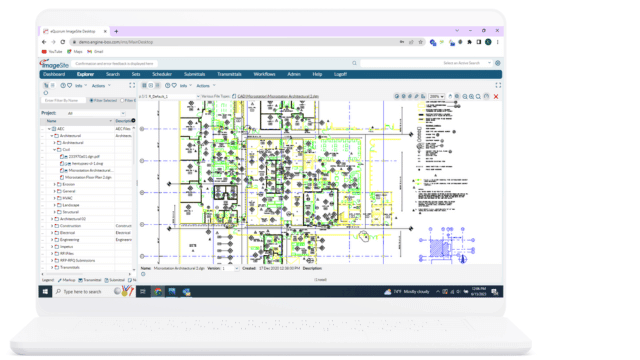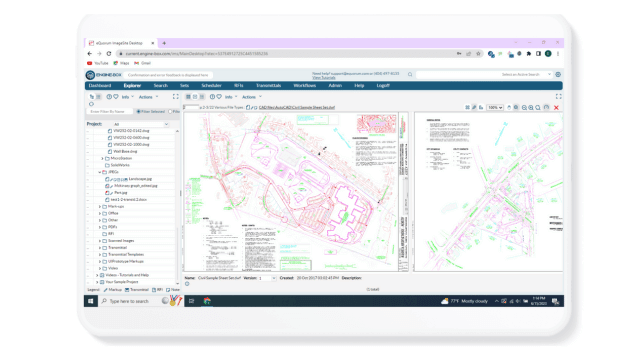Using Automation To Manage Construction Workflows
Using Automation To Manage Construction Workflows
The Architecture, Engineering, and Construction (AEC) industry is one of the largest and longest-standing industries in the world. Today, it continues to rapidly expand as demand for both commercial and residential construction grows. The global industry is now valued at $11.16 trillion, with a projected annual growth rate of 6.9% -- faster than most engineering-based industries.
Automation technology has accelerated industry growth
Automation technology has played a role in the industry for quite some time now, and innovations in robotic process automation (RPA), machine learning (ML), and artificial intelligence (AI) have accelerated the industry’s growth. Still, many executives feel as if their organizations are underutilizing automation, as they intend to use new technologies to reduce employee workload and project turnover time.
According to a report by McKinsey, 45% of current paid activities can be automated using today’s technology, equating to nearly $2 trillion in total annual wages. The company surveyed 1500 executives across all industries and regions. Of this group, 66% of respondents said that addressing potential skills gaps related to automation/digitization was a top-ten priority, and almost 30% claimed it was a top-five priority. Automation technology can be broadly defined in most industries, as it helps companies complete a vast array of different types of assignments. Organizations can automate tasks ranging from manual labor to engineering review and approvals and can reduce the workload of both low-level laborers as well as C-level executives. In fact, studies show that roughly 90% of all employees engage in repetitive tasks that can be automated.
Today, AEC organizations can utilize automation to improve existing processes and ensure the accuracy and timeliness of a project. While large companies were among the first to explore automation, SMBs can use workflow automation to gain a competitive edge over their competitors, and complete projects within a shorter timeframe and ensuring nothing falls through the cracks.
Here are a few ways AEC companies can utilize automation to improve existing processes and ensure the accuracy and timeliness of projects.
1) Engineering and construction workflows
2) Document-centric workflow automation
Engineering and construction workflows
Engineering workflows help organizations coordinate interactions between different disciplines in the engineering and construction process. The architect, who is typically seen in the early stages of an AEC workflow, creates a design that is then sent to the structural, mechanical, electrical, and plumbing engineers, along with contractors involved in the project. The engineers work together to create the drawings used by contractors during the construction phase of the project.
The structural engineers typically start by creating the schematic design (SD), based on the preliminary designs provided by the architect. The structural engineers focus only on the gravity layouts and lateral concepts in this stage. Once this stage is complete, they will often begin work in the design development (DD) stage, where they ensure the correct sizing and geometry of the design.

Engineering Workflow
Automatically manage and distribute files and documents for review, approval, and processing. Adjust user permissions at each step, ensuring your company’s files are managed securely.
Subsequently, structural engineers develop the construction documents (CD), used by contractors for the building construction. There are key differences between design development drawings and construction drawings, for example, the supports used to ensure the structural integrity of the building.
Permitting is required before the building can be constructed and drawings are submitted to ensure the plans comply with federal, state and city standards. Once approved, plans enter the construction administration (CA) phase, also known as the construction support services (CSS) phase, during which the company will receive fabrication drawings, and parts will be fabricated or ordered. Requests for information (RFIs) and submittals are typically used by contractors during this stage to clarify or fill gaps in the information provided by the engineers. RFIs need to be well-managed to ensure the timeliness of responses and to ensure there are no unnecessary project delays.
Document-centric workflow automation
Time is of the essence for AEC companies. It’s one of the few finite resources required to fulfill many of the contractual obligations of owners and other stakeholders. If a project is confined to a linear, task-centric workflow, it can create damaging bottlenecks, that often lead to miscommunication and project delays. While task-centric workflows are efficient by nature, there are many scenarios in which they can’t be used. These scenarios facilitate the requirement for a more complex workflow configuration, such as a document-centric workflow.
Managing document-centric workflows can be difficult, as multiple engineers are required to collaborate over the same documents simultaneously. Workflow automation, however, can simplify this process. Workflow automation uses rule-based logic to automate manual processes, like data entry or the actions a document takes within an engineering document management system (EDMS). Workflow automation software allows engineers to define their work as a series of interrelated steps with automated actions and assigned deadlines, and can even help workers visualize and understand them. When using a workflow management system, workflow administrators can create conditions that documents must meet to trigger an action. Actions are then performed automatically within the system, eliminating the need for engineers to complete the tasks themselves.

Engineering Change Request Solution for AEC Industry
1:25 min
Changes required during later phases of the design process greatly impact project costs and schedules. AECs need a rigorous engineering change management process to keep projects on track.
Automating engineering change order processes
For example, engineers can automate processes such as engineering change orders (ECO) or other linear, document-centric workflows. The ECO is a request for a change to a product design or drawing, and typically requires reviews and approval. Automated workflows ensure all documents in this process are properly versioned and that none are lost as they’re passed between reviewers and approvers. The system can also ensure a document or drawing is not changed or elevated before undergoing critical reviews.
Automating the management of engineering RFIs/submittals
Additionally, engineering workflow and document management systems can be used to help manage RFIs throughout the construction administration phase so they comply with the requirements specified in the contract and the vendor is responsive to the contractor or owner’s request. RFIs can be submitted as standardized forms with a set of requirements, which can be easily managed through the workflow management software, ensuring all RFI workflow participants have visibility into the request and are given scheduled tasks to execute to complete the RFI.

What Is an Engineering Submittal and Why Is It Important?
The submittal review process provides checks and balances during the construction phase of a project. Submittals are often used for quality control, and help project owners understand what they’re getting themselves into.
Additional EDMS Features
Our EDMS solutions
ImageSite and EngineBox are eQuorum’s robust workflow and document management solutions, created to help workers manage their essential workflows while maintaining complete control over their engineering files and documents. Not only do they provide a secure collaboration site for workers, but they also help organizations manage document distribution with third parties like vendors, contractors, and customers. Both systems are offered at a competitive price, enabling organizations to get a quick return on their investment by providing the features and functionality needed to help organizations improve efficiency, productivity, and collaboration. Companies can choose from concurrent user subscriptions or named user subscriptions, ensuring organizations have subscription options that make sense for their business.

ImageSite®
Our single source engineering workflow and document management system. Built in HTML5 so there is no software to deploy to client computers or mobile apps to download. Offered as an On-premise or Private Cloud system.
EngineBox™
EngineBox is a cloud based workflow and document management version of ImageSite that resides outside the corporate network.
Our EDMS solutions
ImageSite and EngineBox are eQuorum’s robust workflow and document management solutions, created to help workers manage their essential workflows while maintaining complete control over their engineering files and documents. Not only do they provide a secure collaboration site for workers, but they also help organizations manage document distribution with third parties like vendors, contractors, and customers. Both systems are offered at a competitive price, enabling organizations to get a quick return on their investment by providing the features and functionality needed to help organizations improve efficiency, productivity, and collaboration. Companies can choose from concurrent user subscriptions or named user subscriptions, ensuring organizations have subscription options that make sense for their business.

EngineBox™
EngineBox is a cloud based workflow and document management version of ImageSite that resides outside the corporate network.
The eQuorum Customer Promise
In 2005, eQuorum developed the first all browser-based EDMS. The system, although for on-premise use, was still created to remove client software and JAVA from user computers and allow users to have a single viewer based on the simple navigation functionality of browsers. Today, eQuorum provides that same application in a private Cloud or a SaaS Cloud option. We can do this because we are, and have always been, browser-based, understanding the enhanced speed, security, and usability of this technology.
With the abundance of document management systems on the market today, there’s no doubt that choosing the right Cloud document management software can be a difficult decision. eQuorum is here to provide a comprehensive, powerful, and most importantly – affordable Cloud document management solution. We believe in providing real value to our customers by eliminating unnecessary costs, providing industry-leading functionality, and equipping your team with the right tools using cutting edge technology to bring your products to market faster.
eQuorum®
We specialize in engineering workflow and document management. Our comprehensive, yet easy-to-use software provides the solution to manage data from design to manufacturing and production, to sales, support and administration.